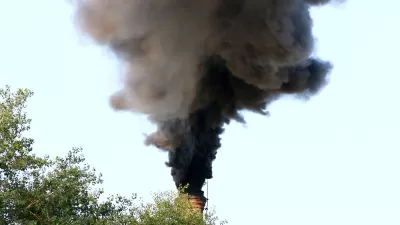An NAS study released July 08 shows that if you live in north of the Huai River in China, you can expect to live about 5.5 years less than those to the south. Air pollution, specifically particulate matter from burning coal, is the primary culprit.
Between 1950 and 1980, China gave free or subsidized heat to those living north of the Huai, and continues to subsidize it. Turns out, the price is anything but free, according to the findings of a study released July 08 in the Proceedings of the National Academy of Sciences (PNAS). Jonathan Kaiman, the Guardian's China correspondent based in Beijing, writes that the study "claims to show in unprecedented detail the link between air pollution and life expectancy."
The researchers, based in Israel, Beijing, and the Massachusetts Institute of Technology, gauged the region's air quality according to the established metric of "total suspended particulates (TSP)," representing the concentration of certain airborne particles per cubic meter of air. [In 1987, EPA replaced the earlier Total Suspended Particulate (TSP) air quality standard with Particulate Matter (PM-10)].
The Chinese government subsidy of the free heat in the north enabled the researchers to study the two different populations. South of Huai River, they too pay a price - in the form of less heat during the winter, but they also breathe cleaner air.
The study concluded that long-term exposure to air containing 100 micrograms of TSP per cubic meter "is associated with a reduction in life expectancy at birth of about 3.0 years."
Researchers determined that PM-10 reduces longevity primarily by exacerbating cardiorespiratory illness.
This is not the first study to establish "a link between air pollution and reduced life expectancy. One recent large-scale study (reported here) concluded that air pollution contributed to 1.2 million premature deaths in China in 2010."
Yet according to Michael Greenstone, an economics professor at MIT and one of the study's authors, this study is the first to precisely quantify their relationship. "The most important question that needed to be answered, is what's the loss of life expectancy? How much should society be willing to pay to avoid high levels of pollution? This study was structured so we could answer that question."
Many may recall reading in January, "Beijing Smog Levels "Off The Scale" which Kaiman called, 'airpocalypse' smog. Kaiman writes that China's leaders "are keenly aware that environmental degradation has become one of the country's leading causes of social unrest. Last month, China's cabinet revealed 10 new measures intended to combat air pollution."
Interested readers are encouraged to listen to a 5:49-minute broadcast by Steve Curwood, the host of "Living on Earth", who interviews Michael Greenstone on the paper's findings, embedded in the July 16 PRI article, "New research discovers vast impact on lifespan from China's pollution."
FULL STORY: China's reliance on coal reduces life expectancy by 5.5 years, says study

Planetizen Federal Action Tracker
A weekly monitor of how Trump’s orders and actions are impacting planners and planning in America.

Congressman Proposes Bill to Rename DC Metro “Trump Train”
The Make Autorail Great Again Act would withhold federal funding to the system until the Washington Metropolitan Area Transit Authority (WMATA), rebrands as the Washington Metropolitan Authority for Greater Access (WMAGA).

The Simple Legislative Tool Transforming Vacant Downtowns
In California, Michigan and Georgia, an easy win is bringing dollars — and delight — back to city centers.

The States Losing Rural Delivery Rooms at an Alarming Pace
In some states, as few as 9% of rural hospitals still deliver babies. As a result, rising pre-term births, no adequate pre-term care and "harrowing" close calls are a growing reality.

The Small South Asian Republic Going all in on EVs
Thanks to one simple policy change less than five years ago, 65% of new cars in this Himalayan country are now electric.

DC Backpedals on Bike Lane Protection, Swaps Barriers for Paint
Citing aesthetic concerns, the city is removing the concrete barriers and flexposts that once separated Arizona Avenue cyclists from motor vehicles.
Urban Design for Planners 1: Software Tools
This six-course series explores essential urban design concepts using open source software and equips planners with the tools they need to participate fully in the urban design process.
Planning for Universal Design
Learn the tools for implementing Universal Design in planning regulations.
Smith Gee Studio
City of Charlotte
City of Camden Redevelopment Agency
City of Astoria
Transportation Research & Education Center (TREC) at Portland State University
US High Speed Rail Association
City of Camden Redevelopment Agency
Municipality of Princeton (NJ)




























